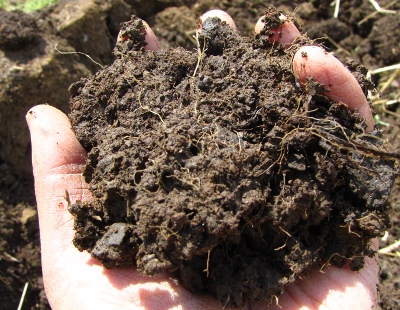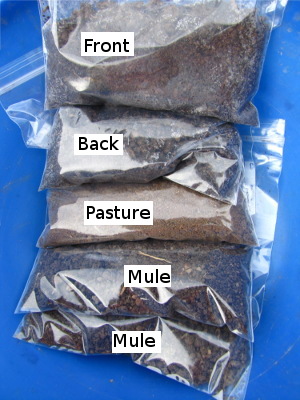
Can you have too much organic matter in your soil?
 My findings that adding
lots of organic matter actually helped equalize cation levels in the
forest garden leads me into a discussion of the most controversial
part of Steve Solomon's book. He agrees with the organic status
quo to a certain point, recommending that we add organic matter until
our soil contains 4% organic matter in the south and 7% in the north,
and until our CEC is at least 7, levels that are achieved through
topdressing half an inch of compost per year. However, Solomon
argues that after you reach your organic matter goal, you should back
off to topdressing with only a quarter inch of compost per year since
adding too much organic matter unbalances your soil.
My findings that adding
lots of organic matter actually helped equalize cation levels in the
forest garden leads me into a discussion of the most controversial
part of Steve Solomon's book. He agrees with the organic status
quo to a certain point, recommending that we add organic matter until
our soil contains 4% organic matter in the south and 7% in the north,
and until our CEC is at least 7, levels that are achieved through
topdressing half an inch of compost per year. However, Solomon
argues that after you reach your organic matter goal, you should back
off to topdressing with only a quarter inch of compost per year since
adding too much organic matter unbalances your soil.
Organic matter is
closely linked to nitrogen, and that was my first concern when I
considered Solomon's low-compost policy. Each 1% organic matter
in your soil releases about 15 to 25 pounds of nitrogen per acre per
year, and high-demand vegetables need around 200 pounds per acre.
If you run your garden hard, like I do, you might end up growing two
low-demand crops and one high-demand crop each year, for a total
requirement of 400 pounds of nitrogen per acre, but a more average
yearly demand would be 200 to 300 pounds.
Time for some
math. The 8.95% organic matter already in my front garden (which
is my best soil) would release 179 pounds of nitrogen per acre
annually, but I need another 100 pounds or so. How do I make up
the nitrogen deficit if not with compost? Solomon uses purchased
additions of seed meals, feather meal, and fish meal to bring his
nitrogen levels up to par.
| Location | %OM | pH | Ca % sat | Mg % sat | K % sat |
| Powerline pasture | 2.74 | 5.1 | 29.23 | 13.57 | 6.96 |
| CP5 | 4.27 | 5.9 | 48.26 | 16.23 | 10.63 |
| Mule garden | 4.87 | 6.9 | 70.58 | 17.94 | 5.06 |
| Forest aisles | 5.43 | 6.3 | 52.66 | 17.55 | 12.25 |
| CP3 and CP4 | 5.48 | 5.9 | 52.56 | 14.77 | 7.96 |
| Front berries | 6.53 | 7.1 | 66.25 | 20.12 | 8.7 |
| Back garden | 7.82 | 7.1 | 69.78 | 19.35 | 5.92 |
| Blueberries | 8.49 | 6.5 | 61.16 | 19.04 | 6.6 |
| Front garden | 8.95 | 7.3 | 68.47 | 19.92 | 7.08 |
| Forest garden | 9.95 | 7.2 | 59.45 | 24.96 | 10.78 |
 While
I'm not adamantly opposed to buying nitrogen amendments if it would
make my garden healthier, my soil tests bring that assertion into
question. In the table above, higher organic matter levels seem
to match up with sweeter soil and with a better ratio of
cations. The
exception is the mule garden, which I think must have had the organic
matter levels mismeasured this year. My
previous year's results showed the mule garden as
having the highest organic matter levels, and my eyes back up that
claim.
While
I'm not adamantly opposed to buying nitrogen amendments if it would
make my garden healthier, my soil tests bring that assertion into
question. In the table above, higher organic matter levels seem
to match up with sweeter soil and with a better ratio of
cations. The
exception is the mule garden, which I think must have had the organic
matter levels mismeasured this year. My
previous year's results showed the mule garden as
having the highest organic matter levels, and my eyes back up that
claim.
Granted, there is a
limit to how much nitrogen vegetables can use each year, but I estimate
you'd have to raise your soil up to 20% organic matter before nitrogen
would start washing out into the groundwater. I think I'll stick
to my Rodale approach to nitrogen and organic matter until someone
presents a stronger argument for seed meals.
This
post is part of our The Intelligent
Gardener lunchtime series.
Read all of the entries:
|
Want more in-depth information? Browse through our books.
Or explore more posts by date or by subject.
About us: Anna Hess and Mark Hamilton spent over a decade living self-sufficiently in the mountains of Virginia before moving north to start over from scratch in the foothills of Ohio. They've experimented with permaculture, no-till gardening, trailersteading, home-based microbusinesses and much more, writing about their adventures in both blogs and books.
Want to be notified when new comments are posted on this page? Click on the RSS button after you add a comment to subscribe to the comment feed, or simply check the box beside "email replies to me" while writing your comment.

I can see seed meal fitting in if you are also growing grains, but I don't think buying input is the answer to a lot of these questions. I could see the power-line pasture playing double duty producing straw and seed meal.
It's too bad hemp is illegal, it could fill a number of needs-deep bedding for the chickens, soil improvement, mulch, seed meal, food, and fire starting material, just to name a few!
If compost is mature enough, then I'm not sure one can put too much in the soil. Mature compost is, afterall, essentially humus. Immature compost would still contain a good deal of cellulose which could adversely affect the soil structure.
As you know, any organic source of N (amino acids, nucleic acids or urea) has to be digested by soil microbes and turned into the nitrates that are absorbed by the growing plants. Other microbes can take ammonia and make nitrates. One could dilute store-bought "ammonia" and apply it periodically. Although a good deal of this is lost as it out-gasses, it's a pretty cheap source of N. Jerry Baker's home made fertilizer utilizes this source, adding molasses, beer and dish soap, but I don't think those are really necessary.
Lots of fascinating comments on this post (and on Monday's, which I got too busy to answer....)
I think that Jackie is spot on that Solomon is a fan of seed meal because of dealing with cold weather. On the other hand, it seems like there are homegrown solutions to low soil availability in cold weather --- like diluted urine.